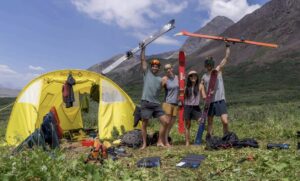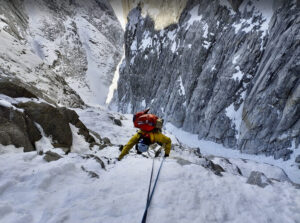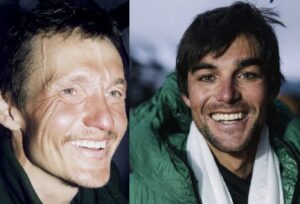What happens when two teams fly to Nepal with the same first in mind? Often, one of them changes its objective in order not to interfere and keeps its options for the coveted first. Other times, the two join forces.
In the case of two groups of young French guides aiming for Ratna Chuli (7,035m), they took plan B. As a result, they all had a blast and returned home with three first ski descents on 6,000’ers and 7,000’ers and possibly the first ascent of Hulang Go, (6,687m).
Maud Vanpoulle and Victor Colombie on one team and Aurelia Lanoe, Firmin Fontaine, Damien Coelho-Mandes, and Bastien Levy on the other were looking for peaks to ski in Nepal. Both asked Paul Grobel and Jean Annequin for advice. The two veterans directed the youngsters to Ratna Chuli, in central Nepal on the border with Tibet, and suggested that they team up. Annequin had climbed Ratna Chuli in the year 2000, four years after the first ascent of the peak by a Japanese team.
The six young French ski mountaineers soon pooled their resources, and everyone worked as if they had been long-time friends.
Lower but wilder
Perhaps one of the reasons why the teams got along so well was their similarity in experience and goals. Except for Aurelia Lanoe, who had been on a ski expedition to Gasherbrum II, none of them had ventured beyond 7,000m. Nor were they seeking the highest or the most difficult peak. Rather, they wanted a summit and ski descent within their abilities. They also wanted to enjoy themselves and avoid the most popular spots.
“We wanted to escape the crowds and aim for something less high but wilder,” Lanoe told Montagnes Magazine. “The Ratna Chuli is not super-prestigious, but we didn’t meet anyone in three weeks at base camp!”
Lanoe speaks of moderately cold weather, pretty good snow (sometimes quite hard), and a lot of laughter and shared feelings, even though the two teams only met in Kathmandu.
The trip to Ratna Chuli started by road in Pokhara. They shared the trek to Himlung (a popular trekking peak) but turned northwest before Himlung Base Camp.

Ratna Chuli sits at the upper right corner, on the Tibetan border. It is northwest of the Annapurna massif, lower left. Map: Google Maps
Low expectations, great results
Maud Vanpoulle says that despite starting with lower expectations, this expedition worked out brilliantly. “Three first ski descents, two possibly unclimbed summits, snow ramps as steep as they are meant to be, and a good grip for the edges. What else could I ask for?”
Vanpoulle noted that once the team reached base camp, the weather was almost entirely good, so they could choose their goals and schedules freely. First, they headed for Upche (6,100m), a peak right in front of base camp.
The skiers were not yet acclimatized and not very confident that they would actually reach the summit. “But we kept our doubts to ourselves and step by step, we found our way to the top,” she said. They then skied all the way down.
The fast ascent took a toll on Bastien, who suffered from altitude sickness and had to go to rest down the valley for a few days. He then returned fitter, stronger, and on time to join the second ascent.
Ratna Chuli
After setting up a higher camp near Ratna Chuli, the group decided that instead of focusing on a single objective, they would first try a nearby summit. As far as they knew, 6,687m Hulang Go had never been climbed.
The ascent took place in bitter cold and very hard snow. The team progressed on crampons up 50º slopes, with skis on their backs. Once on top, they found a line with slightly better snow. They skied down against a backdrop of Annapurna, Dhaulagiri, and the brown Tibetan plains.
By now, they were ready for Ratna Chuli. After waiting some days for the high winds and very cold temperatures to subside, the team set off up the west face at 2 am. They reached the summit in the day, in near-zero winds. All six summited together, then skied down the 40º to 50º slopes in hard but not icy snow.






